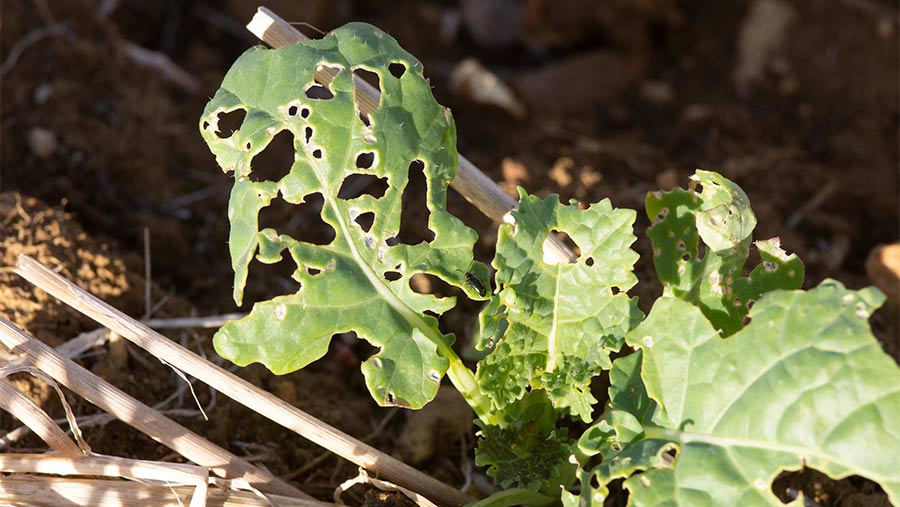Why volunteers and direct-drilling is key to CSFB control
 © Tim Scrivener
© Tim Scrivener Presence of cereal volunteers in oilseed rape fields and direct-drilling could lead to a marked reduction in damage caused by cabbage stem flea beetle (CSFB), according to a recent Rothamsted study.
The results suggest that relatively simple changes in crop management could help control this pest which, in recent years, has led to many famers abandoning the crop altogether.
The field trials were conducted as part of the EU-funded EcoStack project over four seasons in Harpenden, Hertfordshire and with collaborators from the University of Kassel in Germany.
See also: Tips on growing successful oilseed rape companion crops

Flea beetle damage on OSR © Tim Scrivener
The trials assessed OSR crop damage caused by adult CSFB feeding and larval infestation when sown with different companion plants.
These included clovers and cereals to simulate delayed application of herbicide to kill volunteers. Application of straw mulch was also tested to simulate drilling into stubble trash.
Dr Sam Cook, who led the study, said: “Plant diversification, especially sowing crops with the addition of companion plants, has been shown to improve insect pest control in many cropping systems.”
For OSR, the need to find similar effects is acute. Since the ban on use of neonicotinoid seed treatments in 2013, CSFB pest infestations have rocketed and the amount of OSR harvested in the UK has fallen by 50%.
“We wanted to see if control methods that are aligned with regenerative agronomic practices could help provide some protection,” says Sam.
The adult beetles damage the OSR plants by feeding on cotyledons and young leaves early in the autumn, which can threaten crop establishment. The larval stages also feed in the stem causing reduced yield.
Neonicotinoid seed treatments were an effective method of control, but with the EU-wide ban in place due to concerns over environmental impact, and the increase in CSFB populations resistant to pyrethroid insecticides, farmers are left without efficient options to manage this pest.
Feeding damage
The team found significant differences in the level of feeding damage between treatments in all experiments.
OSR with cereal companion plants or with straw mulch showed the strongest reduction in adult feeding damage.
A protective effect of clover was also observed in one trial. Differences in larval infestation were also observed between treatments, but were not consistent and might be more related to the OSR plant biomass than to treatments.
“This study shows that companion planting can protect OSR crops from both CSFB adult feeding damage and larval infestation,” says Gaëtan Seimandi-Corda, who managed the experiments.
“These results suggest that farmers could relatively easily adopt new control techniques, but there is a need for more research to define the best agronomical practices.”
Oats
Cereals such as oats could be sown as companion plants which are later removed, or cereal volunteers could be left for longer before removal to provide protection from CSFB.
The timing of the volunteer removal or the sowing date of companions is essential for efficacy and to avoid competition between the crop and the companion.
Companion plants can also deliver additional ecosystem services such as reduced infestation by other insect pests or improved weed management.
“We are now learning that increased plant diversity can promote an increased diversity of beneficial insects within the field,” says Gaëtan.
“That can help farmers to farm more sustainably and mitigate some of the negative effects of food production on the environment.”
